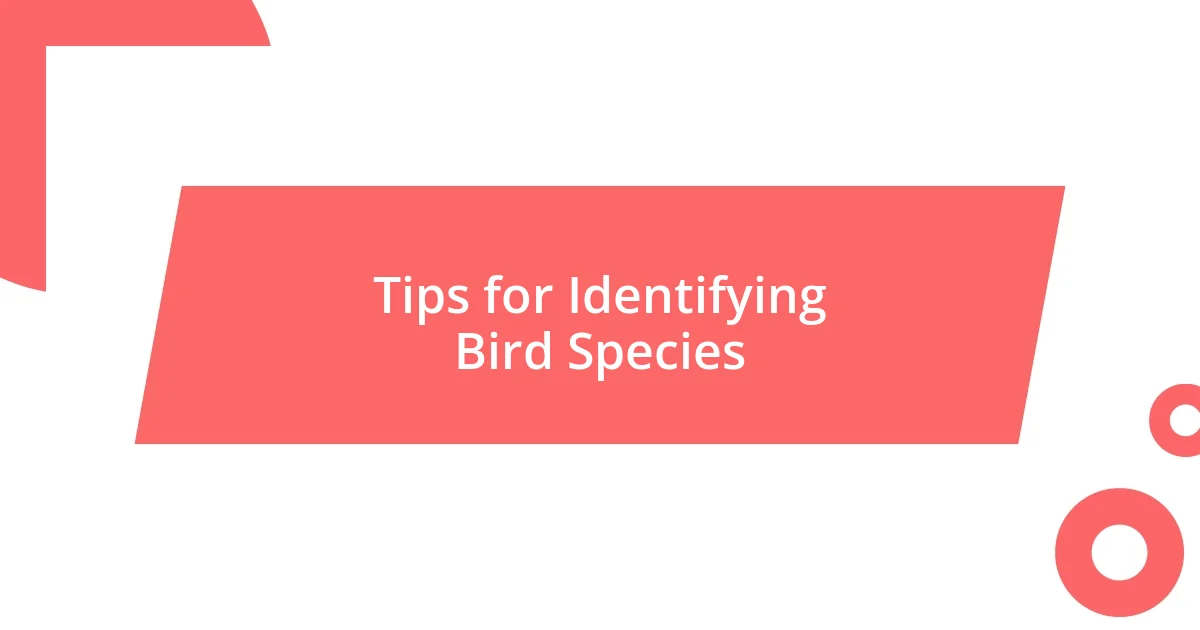Key takeaways:
- Birdwatching is about connecting with nature, observing local species, and developing patience and listening skills to enhance the experience.
- Investing in quality gear, such as binoculars and a lightweight backpack, greatly improves the birdwatching experience and comfort during outings.
- Respecting wildlife and their habitats is crucial; mindful practices and educating oneself about local species contribute to conservation efforts.

Understanding Birdwatching Basics
Birdwatching is more than just spotting birds; it’s about connecting with nature and appreciating the beauty around us. I remember my first outing, wide-eyed and filled with excitement. As I quietly observed a vibrant cardinal perched on a branch, I realized I was truly experiencing the world in a new way. Isn’t it fascinating how a fleeting glimpse of a bird can spark such joy?
Understanding the basics means familiarizing yourself with common species in your area. I often find it helpful to carry a bird guidebook or use an app on my phone. You might wonder, “How do I even start?!” A simple tip is to get to know the sounds of local birds; by learning their songs, you’ll enhance your ability to locate them amidst the rustling leaves.
Another core aspect of birdwatching is the importance of patience and observation. I recall spending an entire afternoon in silence, just waiting, when suddenly a flock of blue jays burst into view. That moment was exhilarating! It taught me that sometimes, the most rewarding experiences arise from simply being still and allowing nature to unfold at its own pace. How often do we rush through our days, missing out on these little wonders?

Choosing the Right Gear
Choosing the right gear for birdwatching can significantly enhance your experience. I remember when I first ventured out with a pair of cheap binoculars, struggling to focus on a distant hawk. It was frustrating! Investing in quality binoculars made all the difference; crisp images and a wide field of view helped me appreciate the nuances of each bird’s plumage.
When selecting gear, consider what fits your personal style and comfort level. Lightweight backpacks, often underrated, have been invaluable for longer hikes. I prefer models with hydration systems, ensuring I’m refreshed while keeping both hands free for birding. And trust me, finding the perfect pair of binoculars is akin to discovering a new best friend in the field—you won’t regret taking the time to choose wisely.
Here’s a quick comparison of essential birdwatching gear that I’ve found useful. Each piece serves a different purpose, so understanding them beforehand can save you time and effort.
| Gear Type | Features |
|---|---|
| Binoculars | High magnification, lightweight, waterproof |
| Field Guide | Visual and audio guides, portable app options |
| Comfortable Shoes | Good traction, breathable material, ankle support |
| Backpack | Lightweight, hydration compatible, durable |

Best Locations for Birdwatching
Choosing the best locations for birdwatching can significantly shape your experience. I’ve discovered that proximity to a variety of habitats—like wetlands, forests, and grasslands—can heighten your chances of spotting diverse bird species. One of my most memorable outings was at a local nature reserve, where the interplay of different environments attracted an array of birds, from elegant herons to lively warblers flitting about. The thrill of encountering a rare sighting, like an elusive woodpecker, still sends shivers down my spine!
Here are some of my top locations to consider for birdwatching:
- National Parks: Vast spaces teeming with wildlife.
- Wetland Areas: Great for spotting waterfowl and migratory birds.
- Urban Green Spaces: Surprisingly productive for observing common city birds.
- Nature Reserves: Dedicated habitats that often promote diverse ecosystems.
- Coastal Regions: Ideal for seabirds and shorebirds; the sound of waves in the background is a bonus!
Exploring these locations can be a delightful journey. Each outing has its unique charm, often unfolding new surprises along the way. I remember feeling a rush of excitement as I stood by a tranquil lake, listening to the croaking of frogs and the soft rustle of wings as a majestic eagle soared overhead. It’s in those moments that the beauty of birdwatching truly resonates with me.

Techniques for Spotting Birds
I’ve found that mastering the art of observation is crucial when birdwatching. One technique I often use is to “listen first.” Birds can be more readily heard than seen. I remember one crisp morning when I sat quietly, absorbed in the soft symphony of chirps and tweets. Suddenly, the flurry of feathers darting through the trees revealed a vibrant cedar waxwing. It was a reminder: patience and active listening can lead to incredible discoveries.
Another effective technique is to blend into your surroundings. Birds are skittish creatures, and the more you mimic the natural environment, the better. When I donned muted colors and sat against a large tree trunk, I felt like part of the landscape. That day, a flock of goldfinches landed just a few feet away, unconcerned by my presence. How exhilarating is that moment when birds come into focus, giving you a front-row seat to their world!
Using a birding app or field guide app on your smartphone can also enhance spot-checking. I fondly recall an afternoon spent by the river, struggling to identify a song echoing from the bushes. With a quick glance at my app, I was thrilled to pinpoint it as a common yellowthroat. The joy of technology blending with nature opens new avenues for us birdwatchers, doesn’t it? It transforms what can sometimes feel like a solitary venture into an engaging learning experience.

Tips for Identifying Bird Species
One of the most effective ways to identify bird species is to pay close attention to their physical characteristics. I often find myself captivated by the vibrant colors or striking patterns on a bird’s feathers. Just last summer, while hiking in the mountains, a flash of blue caught my eye. It turned out to be a stunning indigo bunting, and the experience reminded me how crucial it is to look beyond general shapes and sizes. Taking a mental snapshot of a bird’s unique markings can be a game-changer for identification.
When you’re out in the field, taking note of a bird’s behavior can be equally insightful. I still remember watching a red-tailed hawk soaring effortlessly in the sky. It was its hunting pattern—circling and diving—that helped me recognize it among other raptors. Observing how birds interact with their environment provides essential clues to their species, wouldn’t you agree? Noticing details like feeding habits or social interactions can unlock a wealth of knowledge and deepen your understanding of the avian world.
Another handy tip is to familiarize yourself with local birds through regular observation. This way, you create a personal reference of the species you might encounter. I often keep a journal of my sightings, jotting down specifics such as the location, time, and behaviors I witness. On one occasion, I spotted a pair of nesting blue jays in my backyard, and watching them raise their young not only enchanted me but also solidified my recognition of their calls. Don’t underestimate the power of connecting with your local feathered friends—each observation enriches your birdwatching journey!

Keeping a Birdwatching Journal
Keeping a birdwatching journal is something I genuinely cherish. Each entry feels like a time capsule, capturing fleeting moments in nature that can easily slip away. I remember sitting on my favorite park bench, watching a brilliant red cardinal hop along a branch, and there I was, feverishly scribbling down every detail—the way the sunlight caught its feathers and how its cheerful song lifted my spirits. Isn’t it fascinating how writing can preserve these ephemeral experiences?
I’ve also found that documenting my observations enhances my learning. After a day of birdwatching, I like to reflect on my encounters, noting not just what I saw but also how I felt in those moments. Recently, while observing a majestic great horned owl silhouetted against the twilight sky, I felt an overwhelming sense of peace. Writing about that evening helped me internalize the experience and remember not just the owl, but also the deep calm it brought me. Does journaling hold the power to transform a simplesight into a lasting memory? I believe it does.
With each page filled, I can trace my progress as a birdwatcher. Looking back on my earlier sightings, I can see how far I’ve come in recognizing behaviors and calls. It’s almost like a journey documented in words, where each species I identify reflects my growth. Once, I flipped through my journal and came across my first entry about spotting a common merganser. I chuckled at my initial excitement over its unique features, realizing now how much I’ve learned since that day. Keeping a birdwatching journal truly not only enriches my experiences but also serves as a personal reminder of the beauty and complexity of the avian world.

Respecting Wildlife and Habitats
When it comes to birdwatching, respecting wildlife and their habitats should always be a top priority. I recall a trip to a wetlands area where my excitement nearly blurred my judgment; I was about to step over a low fence to get a better view of a heron. Thankfully, I paused and realized that this delicate ecosystem needed to be preserved. Certainly, encroaching on a bird’s territory can not only disturb its natural behavior but also threaten its survival. Have you ever considered how a moment of thrill could lead to long-term damage?
I’ve learned that being mindful of your surroundings goes beyond simply watching from a distance. During one particular outing, I noticed a family of ducks nesting close to a trail. Instead of taking my usual path, I diverted to give them space. It turned out to be a enriching choice; I ended up observing the ducklings learning to swim further along the stream, a sight that felt even more rewarding because I knew I had respected their space. Isn’t it amazing how making small adjustments in our behavior can lead to incredible observations?
Lastly, I’ve found that educating myself about the local wildlife not only enhances my experience but also helps in their conservation. I often read up on the species in the area before heading out, and I’ve even attended local conservation meetings. Once, I met someone who had dedicated their life to protecting a nearby bird sanctuary. Hearing their passion inspired me to do my part—whether it’s picking up litter on my walks or spreading awareness about the importance of preserving natural habitats. Doesn’t it feel good to envision a world where both birdwatchers and wildlife can flourish side by side?















